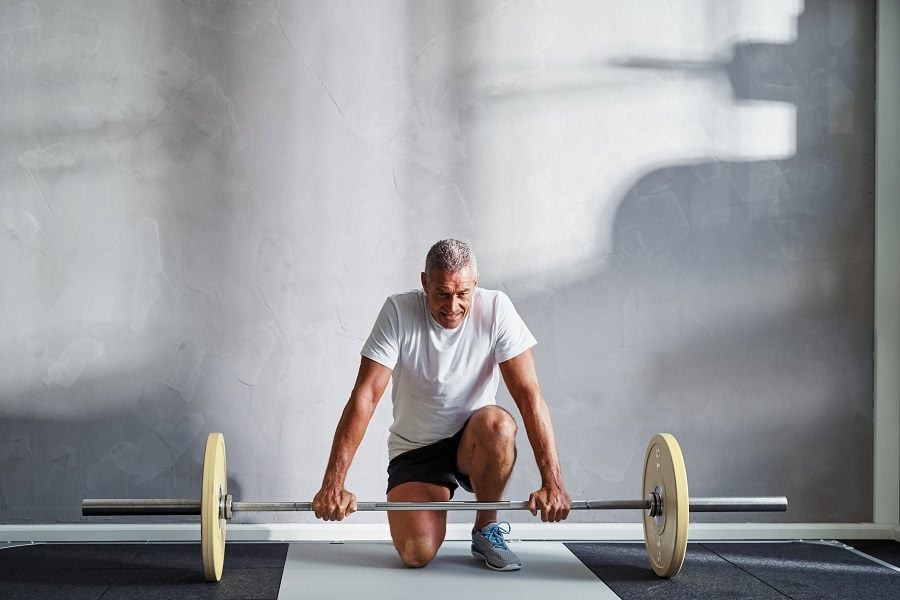There’s a good chance you know someone with hypertension — or perhaps you have it yourself. The Centers for Disease Control and Prevention reports affects one in every three Americans. And though there are typically no symptoms associated with the condition, it’s still incredibly dangerous and can lead to heart attacks or strokes later on. For this reason, it’s important to do everything you can to keep your blood pressure in a healthful range.
Aside from medication, there are plenty of actions you can take to combat high blood pressure. Here are the types of exercise you should be doing.
Start with simple exercises

Couple walking | Image Source/Getty Images
If you don’t exercise much already, you don’t have to go from couch to marathon in order to make a difference in your blood pressure. The American Heart Association recommends getting 30 minutes of moderate activity five days a week for a total of 150 minutes. And moderate-level activities can include briskly walking, doing work around the house, swimming, or going for a leisurely bike ride.
Here’s more good news: Everyday Health notes a small study published in the journal Hypertension found when 50 people with resistant hypertension took part in a treadmill walking program for just eight to 12 weeks, they saw vast improvements. This just goes to show how beneficial simple movements can be.
Aerobic activities you should be doing
No treadmill? No problem. Even if you’re not a runner (but you hope to amp up your aerobic activity above just walking), there are plenty of other exercises you should consider. Not only are aerobic activities helpful for blood pressure, but you’ll strengthen your heart overall and load your body with feel-good endorphins.
The Mayo Clinic recommends taking part in a sport if you’re able, like tennis or soccer. Chores like mowing the lawn, gardening, or raking leaves are also working your body more than you think. And swimming, dancing, and cycling at a higher intensity are great options. If you’ve never tried a spin class, they provide a community and accountability aspect to getting a full hour of cardio in — and you can torch around 500 calories in just one session.
Strength training is also key

Senior man preparing to lift a heavy weight | UberImages/iStock/Getty Images
For a well-rounded routine, you’ll want to do more than just aerobics. Strength training is also key for keeping your blood pressure low and your heart healthy. Everyday Health says a small study in the Journal of Human Hypertension studied 15 men with high blood pressure who began weight training three times a week for two weeks total. In just that short amount of time, there was a significant reduction in blood pressure on average.
The Mayo Clinic also notes that while weight training, you may experience a spike in blood pressure — but the long-term benefits certainly outweigh this. To combat this spike, try using lighter weights with more repetitions rather than heavy weights with fewer reps. Remember to breathe through each exercise (it can be easy to hold your breath), and always listen to your body if you feel dizzy or unwell.
Perform a mix of upper and lower body exercises
Unsure of where to begin when it comes to your routine? Try creating a workout that incorporates 20 minutes of aerobics with 20 minutes of weight training for a well-rounded 40-minute workout. And always make sure to add in a five-minute warm-up (light to moderate intensity cardio) and five minutes after your routine to cool down and stretch.
As for the workout itself, personal trainer Jonathan Olivencia recommends alternating between upper body exercises, lower body moves, and core exercises, especially for those who are above the age of 50. This is particularly beneficial for those with high blood pressure because the blood can better circulate when your entire body moves. While focusing on one exercise is a great start, try a routine that incorporates other dynamic movements, like alternating between 60 seconds of high knees, 60 seconds of push-ups, and 60 seconds of crunches, for example.
Always consult with your doctor before starting a new exercise routine as well. They can help you craft the perfect daily workout that will benefit both your heart and mind.
Check out The Cheat Sheet on Facebook!
Source: Read Full Article
